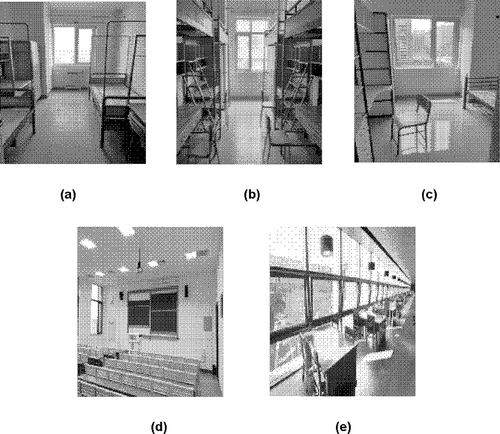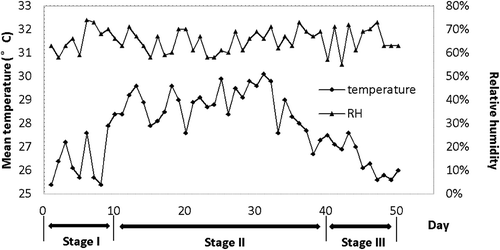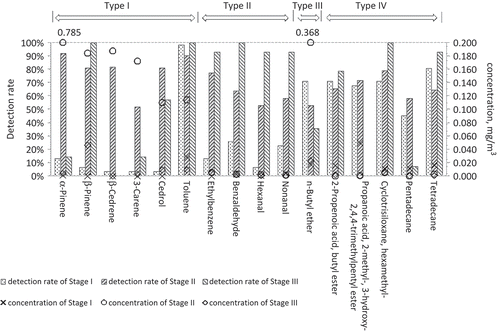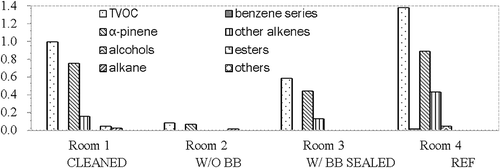ABSTRACT
This study investigates the volatile organic compounds (VOCs) constituents and concentration levels on a new university campus, where all of the buildings including classrooms and student dormitories were newly built and decorated within 1 year. Investigated indoor environments include dormitories, classrooms, and the library. About 30 dormitory buildings with different furniture loading ratios were measured. The characteristics of the indoor VOCs species are analyzed and possible sources are identified. The VOCs were analyzed with gas chromatography–mass spectroscopy (GC-MS). It was found that the average total VOC (TVOC) concentration can reach 2.44 mg/m3. Alkenes were the most abundant VOCs in dormitory rooms, contributing up to 86.5% of the total VOCs concentration. The concentration of α-pinene is the highest among the alkenes. Unlike the dormitory rooms, there is almost no room with TVOC concentration above 0.6 mg/m3 in classroom and library buildings. Formaldehyde concentration in the dormitory rooms increased about 23.7% after the installation of furniture, and the highest level reached 0.068 mg/m3. Ammonia released from the building antifreeze material results in an average indoor concentration of 0.28 mg/m3, which is 100% over the threshold and should be seriously considered. Further experiments were conducted to analyze the source of the α-pinene and some alkanes in dormitory rooms. The results showed that the α-pinene mainly comes from the bed boards, while the wardrobes are the main sources of alkanes. The contribution of the pinewood bed boards to the α-pinene and TVOC concentration can reach up to above 90%. The same type rooms were sampled 1 year later and the decay rate of α-pinene is quite high, close to 100%, so that it almost cannot be detected in the sampled rooms.
Implications: Analysis of indoor volatile organic compounds (VOCs) in newly built campus buildings in China identified the specific constituents of indoor VOCs contaminants exposed to Chinese college students. The main detected substances α-pinene, β-pinene, and 3-carene originated from solid wood bed boards and should be seriously considered. In addition, the contribution rates of building structure materials and furniture to specific VOCs constituents are quantitative calculated. Also, the decay rates of these specific constituents within 1 year are also quantitative calculated in this paper. This study can help us to better understand the sources and concentration levels of VOC contaminants in campus buildings, and to help select appropriate materials in buildings.
Introduction
People spend about 88% of their time staying indoor environment every day, according to a previous study (Robinson and Nelson, Citation1995). The volatile organic compounds (VOCs) are the major indoor pollutants that are harmful to human health (Jones, Citation1999; Brown et al., Citation1994). An investigation about the influence of indoor air total VOC (TVOC) on staff asthma and rhinitis in office building shows that the symptoms are obvious if the TVOC concentration exceeds a limit value (Rios et al., Citation2010). In studies by Zhang et al, formaldehyde, carbonyls, and volatile organic compounds like benzene, toluene, and xylenes (BTX) are main human carcinogens in newly built urban indoor environment (Tang et al., Citation2009; Du et al., Citation2014). Different species of VOCs influence people’s health differently, and the hazards of the aldehydes, ketones, and benzene series are much more serious than for other substances (Salthammer et al., Citation2010; Salonen et al., Citation2009; Sarigiannis et al., Citation2011; Wang et al., Citation2007; Choi et al., Citation2009; Liu et al., Citation2013; Schneider et al., Citation2001).
A study of TVOC concentration in a large underground supermarket performed (Tao et al., Citation2015) in Xi’an, China, found that TVOC concentration ranged from 0.34 mg/m3 to 3.56 mg/m3, mainly originating from interior decoration materials and some merchandise. Studies had been conducted in urban primary schools that were occupied in some countries. Especially in Korea, concentration of TVOC stayed at lower levels (about 0.4 mg/m3) (Mishra et al., Citation2015). However, contribution rates of each source are not discussed and concentrations of individual VOC species are not reported in these research studies. In order to minimize the adverse effects of indoor VOCs (Hollowell and Miksch, Citation1982), the compositions and sources of volatile organic compounds need to be identified.
A seasonal analysis of VOCs constituents conducted in a furniture store in Beijing (Jiang et al., Citation2013) showed that the detected concentrations of the benzene series (0.2 mg/m3) are the highest, followed by acetone (0.0323 mg/m3) and acetaldehyde (0.0228 mg/m3), with TVOC concentration of 0.88 mg/m3. In a study of VOCs characterization conducted in newly built hotels in southern China (Chan et al., Citation2011), wooden interior fixtures and wall panels are identified as the main sources of VOCs detected inside the guest rooms. Obviously, furniture and wood materials are the major indoor VOCs sources. Other than these, building structure materials are also a nonnegligible source. A study of 240 newly built apartments in 15 cities in South Korea, without people and furniture, in terms of the indoor TVOC concentration showed that toluene, ethyl benzene series, and xylene are the substances with the highest detection rates and are related to the structure materials (Lim et al., Citation2011). As a summary of literature researches, the VOC characteristics resulting from building materials and furniture are significantly different in newly built buildings (Kim et al., Citation2001; Yu and Crumpt, Citation1998; Wang et al., Citation2008; Wolkoff, Citation1995).
However, the detected substances are significantly different in occupied houses. Studies showed that the activities and household products of residents who live in occupied houses are the main sources of indoor environmental VOCs such as 1-butanol, related to plastics and paints, heptane, related to solvent, and d-limonene, related to wood products and cleaning products in Hong Kong (Guo et al., Citation2009). Researchers in Canada used the method of positive matrix factorization (PMF) to identify and quantify the possible indoor sources of detected VOC species in occupied houses as well. They have found that household products were main source of VOCs with contribution rate of 44%, and the construction materials only contribute 11% of TVOC mass concentrations with a very low level (Bari et al., Citation2015).
Although more and more researchers have paid attention to indoor VOCs constituents, campus buildings, especially the newly built campus buildings in China, are rarely investigated. However, more and more new college campuses are being built in recent years in China, and most of them are brought into use immediately after completion. College students spend most of their time in dorms, classrooms, libraries, and other indoor environments, which are all newly built, decorated, and laid out. The indoor air quality of these environments would have a great effect on physical health of students. Based on this, the current study is performed in the indoor environment on a new campus, and the test lasted about 1 year. The measured indoor pollutants include formaldehyde, ammonia, and VOCs in dormitory buildings, teaching buildings, and the library before and after installing furniture. Five hundred and eighteen samples for air pollutants were obtained. Experiments are designed to investigate the sources of some main VOC constituents.
Methods
Sampling points
This study was conducted on a new university campus in Tianjin, including 31 dormitory buildings, 10 teaching buildings, and one library building. The test was performed from June to September 2015 in two stages: Stage I was after the completion of the construction and before the installation of furniture; Stage II was within 1 week after the installation of furniture. The students moved into the dormitories soon after completion of Stage II. In addition, a subsequent test was carried out in June 2016, about 1 year after Stage II, named Stage III. During Stage I, Stage II, and Stage III, the windows were regularly opened in daytime and closed at night for natural ventilation in all the three building types. No mechanical ventilation system was used. Also, the ventilation rates were measured by CO2 concentration decay method. Because the floor area of all the tested rooms in dormitories or teaching buildings is less than 50 m2, only one sampling point is set, in the center of each room. The numbers of sampling points are listed in . There are four sets, two sets, and one set of furniture for undergraduate, graduate, and PhD students’ dormitories, respectively. Desks and wardrobes are made up of particleboard and bed boards are made up of pine wood or oak wood. In teaching buildings and the library, newly furnished desks and chairs are laid out as shown in .
Table 1. Sampling points.
Pollutant sampling and analysis method
The measured indoor pollutants included VOCs, formaldehyde, and ammonia. Sampling of volatile organic compounds was performed with TenaxTA sampling tubes (Markes, UK), which can adsorb most VOCs at normal temperature, except for a few lower molecular hydrocarbons, aldehydes, and ketones. According to the Chinese indoor air quality standard GB/T 18883-2002, samples were collected at 1 L/min for 10 min in sealed rooms using sampling pumps named QC-2 (BMILP, China). Room doors and windows were kept closed for 12 hr before sampling, according to the standard. In addition, the temperature and relative humidity (RH) were measured during the period of test in order to characterize VOC species accurately. Analysis of VOCs was done by thermal desorption (Agilent, USA) followed by gas chromatography with mass spectrometry (GC-MS) (Persee, China), using the retention time for compound identification. and NIST98 mass spectral library conformity is greater than 85%. The method detection limit (MDL) for VOCs is 0.01 mg/m3. The signal-to-noise ratio is 3 for VOCs analysis and the measurement error of duplicate samplings for VOCs is 8.76%, which is considered to be acceptable for long-term decay trend observation over months. Toluene-equivalent concentration was used for the quantitative analysis. The concentrations of individual VOCs are calculated by the standard curve of toluene defined as y = Ax + B, where y is the peak area and x is the concentration. TVOC is the sum of all detected VOCs concentrations. Formaldehyde was sampled and analyzed using the acetylacetone spectrophotometric method according to Chinese national standard GB/T 15516-1995. Ammonia was measured using the indophenol-blue spectrophotometric method according to Chinese national standard GB/T 18204.2-2014. Sampling processes and equipment of these two substances are as same as for the VOCs samples except the sampling tubes.
Source identification test
Two extra tests named “bed board test” and “wardrobe test” were conducted for source identification of VOC constituents in order to quantify the contribution of the two major materials in the room: pine-wood boards and particleboards.
Bed boards test
Four rooms with high detection rate of α-pinene and high mean TVOC concentration in undergraduate dormitory were chosen for the source identification test. One of the rooms was a reference room; for all the other three rooms, the surface of the furniture was cleaned with soapy water before other treatments, which was aimed to avoid the interference of VOCs adhering to dust on surface. The test condition of each room is listed in . More specifically, in Room 1, there is no treatment besides cleaning; in Room 2, the bed boards were moved out; in Room 3, the bed boards were sealed with plastic cloths; and Room 4 was the control room without any treatment. These four rooms were sealed for 12 hr before measurements, as for all other tests mentioned in this study.
Table 2. Treatment of selected rooms in “bed board test.”
Wardrobe test
The inner surface of particleboards of the wardrobes has less contact with the air in the room. Thus, the VOCs pollutants emitting from the boards accumulate inside the wardrobes and cannot mix with indoor air quickly. In order to further determine the VOCs species inside wardrobes, VOCs sampling and analysing was performed at three sampling points: inside the sealed wardrobe, in the middle of the room, and above the bed boards. Room 1 of the bed board experiment was selected for this test.
Results
Indoor VOCs, formaldehyde, and ammonia characteristics
Analysis of the samples of 31 dormitory buildings of undergraduate, graduate, and PhD housing, 10 teaching buildings, and one library building at Stage II shows that the total numbers of the detected VOCs constituents in dormitory buildings, teaching buildings, and library building are 568, 178, and 185, respectively. Among all of the constituents, alkenes, alkanes, alcohols, esters, benzene series, ketones, and aldehydes are mainly detected. However, the types () and concentrations () of detected constituents in each kind of buildings are different. The proportion of alkenes is the largest in the dorms of undergraduates (25.34%) and graduates (22.19%), while they make up a smaller part in teaching buildings (14.46%) and the library (11.89%). The reason is that the pinewood bed boards used in undergraduates’ and graduates’ dormitories emit a lot of alkenes, which can be identified in later source experiments. The mean concentration of each VOC in different building types is shown in . The mean concentration of TVOC is 2.44 mg/m3. The dormitory buildings of undergraduate and graduate students should be of more concern, as they provide exposure to an environment of much higher TVOC concentration than in the other buildings. Corresponding to the numbers of VOCs species, the concentration of alkene is about seven times higher than the sum of other constituents, followed by alkane, alcohol, and benzene. Other than undergraduates’ and graduates’ dormitories, PhD dorms, which were furnished with oak bed boards and wardrobes, emitted fewer species of alkenes and lower concentrations of VOCs (Risholm-Sundman et al., Citation1998).
Figure 2. (a) Categories of VOC constituents in different buildings. (b) Mean concentrations of VOC constituents in different buildings.
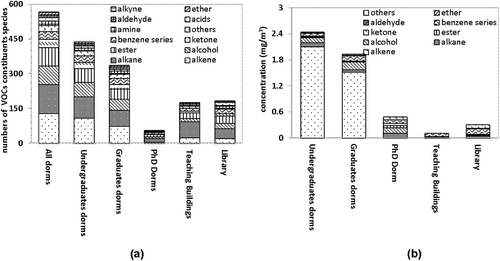
Because the TVOC concentrations of teaching buildings and the library building are below the Chinese national standard of 0.6 mg/m3 and the concentrations of most individual constituents are very low, the current study has focused on the concentration of VOCs in undergraduate students’ dormitories. shows the average concentrations of the top seven main constituents. The concentration of α-pinene is 0.785 ± 0.1 mg/m3, much higher than for the other substances. Toluene, a representative of the benzene series, has a very low concentration, only about 0.01 mg/m3. The average TVOC concentration, which is shown in , is seriously high at 2.44 mg/m3. Obviously, the concentration of α-pinene contributes about one-third of the total concentration.
Concentrations of formaldehyde and ammonia in all kinds of buildings were calculated. For formaldehyde, average concentrations were compared between Stage I and Stage II for dormitories. Teaching buildings and the library were only sampled in Stage II because of the project schedule. As shown in , although the concentrations are all below the limit (China GB/T 18883-2002, 0.1 mg/m3), the increased rates of concentrations (0.055 to 0.068 mg/m3, 0.043 to 0.049 mg/m3, 0.045 to 0.049 mg/m3 in undergraduate, graduate, and PhD dormitories, respectively) from Stage I to Stage II are 23.7%, 13.4%, and 8.9% in undergraduate (4 sets of furniture), graduate (2 sets of furniture) and PhD (1 set of furniture) dormitories, respectively. Obviously, formaldehyde is emitted from not only structure materials (such as foam insulation) but also furniture (such as particle boards and plywood) (Gupta et al., Citation1982).
Figure 4. (a) Average concentrations of formaldehyde in buildings. (b) Average concentrations of ammonia in buildings.
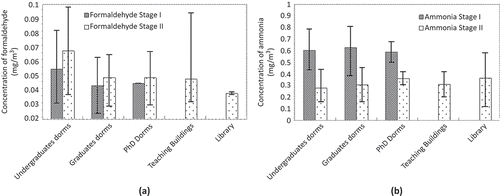
Concentrations of ammonia in all buildings decreased about 53.2%, 50.7%, and 38.3% in undergraduate, graduate, and PhD dormitories, respectively, from Stage I to Stage II, as shown in . Although the decay of ammonia is fast, the average concentration (0.28 mg/m3, 0.31 mg/m3, 0.37 mg/m3 in undergraduate, graduate, and PhD dormitories, respectively) at 1 month after completion of is still much higher than the limit (China GB/T 18883-2002, 0.2 mg/m3). The main source of ammonia is structure material that contains urea-based antifreeze admixtures in concrete cement, and this cannot be neglected in construction of buildings in cold weather (Bai et al., Citation2005).
The outdoor temperature was within 20 to 30ºC for the test period from July to September in Tianjin. The indoor temperature and relative humidity of each test room was also monitored and the mean temperature ranged from 25 to 30ºC and the indoor relative humidity fluctuated from 55% to 75% (), with the relative deviation both less than ±5%. Also, the results of VOC emission characteristics independent of temperature in the typical indoor temperature range from 23 to 30ºC and the effects of relative humidity on VOC emissions were found to be negligible (Sollinger et al., Citation2015). Therefore, the average values were used to denote measured temperature and relative humidity in each sampled room.
The air exchange rates have been measured by a CO2 concentration decay method under typical weather condition (light breeze) in several rooms, and ranged from 4.5 to 5.5 hr−1 under the natural ventilation condition. Because air exchange rate is related to wind pressure, heat pressure and outdoor climate were breezeless or a light breeze when we were sampling indoors. It is considered that the air exchange rates in other rooms were in the same level as in the tested rooms.
Indoor VOCs detection rate
The detection rate is represented by D = F/N, where F is the number of rooms detected with certain VOC and N is the total number of tested rooms. The specific VOCs whose detection rates are more than 50% are listed in for different types of buildings, respectively.
Table 3. VOCs constituents for which the detection rate is more than 50% in dorms, classrooms, and the library.
In order to show the detected VOC contaminants in each building of different types, a two-dimensional diagram is used (). It is the scatter distribution diagram of cumulative percentage of indoor VOC detection rates of detected objects with the detection rates for them in various types of buildings. The y coordinate is detection rate of the detected substance. The x coordinate is the cumulative percentage of the detection rate, which is defined as a ratio of summed rate from the smallest one to this one and total detection rate. Above the red dotted line, the detection rate is more than 50%, and the rate below the line is less than 50%. It can be seen that the scatter density above the dotted line is much smaller than that below the line, which proves that the constituents with detection rates more than 50% are much fewer than the substances with detection rate less than 50%.
Figure 6. Scatter distributions of cumulative percentage of VOC constituent detection rates in their relative detection rates.
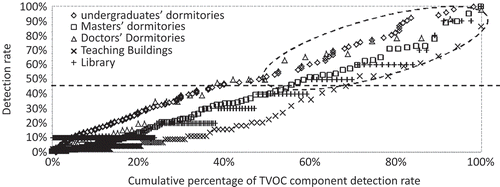
For all dormitories, the constituents with detection rates more than 50% account for only 2.81% of the all constituents, and the proportion of VOCs with detection rates more than 50% in undergraduates’ dormitories, graduates’ dormitories, and Ph.D. dormitories is 7.53%, 6.21%, and 19.67%, respectively. For teaching buildings and the library, the constituents for which detection rates are more than 50% account for 4.49% and 14.59% of all the components, respectively. More detailed information on the detected constituents for which detection rates are more than 50% is shown in .
The substance with the highest detection rate is toluene in all of the buildings. In the dormitory buildings, detection rates of the alkenes represented by α-pinene and d-limonene, alkanes, esters, aldehydes (hexanal), ethers (n-butyl ether), and alcohols (cedrol) are higher, which is mainly related to the contribution of bed boards and wardrobes. In teaching buildings, certain alkanes such as cyclotrisiloxane, n-tetradecane, and n-pentadecane are more frequently detected due to their wide use in the adhesives and paints in classrooms. In the library, except for the alkane substance detected in teaching buildings, the detection rates of some esters like ethyl acetate and the benzene series are also high, which may be related to the wood floors. In the research on VOC released from parquet flooring, researchers have found that many kinds of alkenes are emitted yet at low concentrations. However, esters and the benzene series emitted from the wood floors are at higher levels of concentration than alkenes (Zhao et al., Citation2015).
Comparison of the concentration in three stages
The Stage I and Stage II test lasted for about 3 months, including indoor VOCs sampling in the unoccupied rooms without and with furniture in 10 undergraduate dormitory buildings and 14 graduate dormitory buildings (Stage I and Stage II). The Stage III test involved two undergraduate dormitory buildings and two graduate dormitory buildings in June 2016. Comparing the differences in the VOC constituents in three stages, one can get more in-depth analysis on the sources of indoor VOC constituents.
Constituents for which the detection rates are higher than 50% in Stage II but that were not detected in empty rooms (Stage I) are listed in , and these compounds are noted as Type O, while the others can be detected with much lower detection rates and concentrations in empty ones. It can be considered that the emissions of these VOCs are significantly related to the furniture installation. In Stage III, some of these substances can still be detected while others cannot. In order to calculate the decay rate of these constituents, the detection rate and detection concentrations in Stage III are listed in as well.
Table 4. VOCs constituents detected in Stage II but that do not exist in Stage I (Type O).
The substances that can be detected both before and after furniture installation originated from not only the furniture but also the construction materials. In order to identify the contribution of the two parts for each constituent, detected substance can be divided into four categories according to the differences of concentrations and detection rates before and after furniture installation, as shown in .
Type I: Detection rates increased a lot; so did concentrations. The alkenes and alcohols like α-pinene, β-pinene, β-cedrene, 3-carene, cedrol, and toluene belong to Type I. They come mainly from the furniture boards, and contribute significantly to the total concentration.
Type II: Detection rates increased a lot, while concentrations varied a little. The aldehydes and the benzene series excluding toluene, like benzaldehyde, hexanal, ethylbenzene, and nonanal, belong to Type II. This indicates that these compounds are more common from furniture materials but do not contribute much to the total concentration.
Type III: Concentrations increased a lot but detection rates varied a little. n-Butyl ether belongs to Type III. Similarly, it also comes mainly from the furniture boards.
Type IV: Detection rates varied a little, and so did concentrations. The esters like 2-propenoic acid, butyl ester, propanoic acid 2-methyl- and 3-hydroxy-2,4,4-trimethylpentyl ester, and the alkanes like hexamethyl cyclotrisiloxane, pentadecane, and tetradecane belong to Type IV. The contribution of furniture is not significant, and therefore this type can be regarded as mainly coming from the structure materials.
In summary, the constituents in Types I, II, and III come mainly from the furniture boards with different contribution rates. However, the substances in Type IV mostly come from the building structure materials.
The contribution rates are calculated to quantitatively clarify the contribution of furniture boards and structure materials to total VOCs concentration. For Type O compounds, which cannot be detected in Stage I, the contribution rates of furniture boards are 100%. For Types I and III, whose concentration increased significantly in Stage II, the contribution rates equal (CII – CI)/CII. For Type II, as the average concentrations change insignificantly, contribution rates are defined as (DII – DI)/DII, where CI and CII are the mean concentration in Stage I and Stage II, respectively. DI, DII is the detection rate in Stage I and Stage II, respectively. For Type IV, their concentrations were generally higher in Stage I than in Stage II, and therefore it can be considered that the building structure materials are the only sources, and the contribution rates are considered as 100%.
The decay rates of the constituents whose detection rates are above 50% in Stage II are calculated after 1 year (Stage III) by (CII – CIII)/CII, where CII and CIII are the mean concentrations of the detected constituent in Stage II and Stage III, respectively. Most of the substances except the benzene series have decay rates above 70%. Remarkably, α-pinene, for which the detection rate and concentration are both higher in Stage II, has a high decay rate to 99.56%. However, the decay rates of β-pinene and d-limonene are much slower although their detection rates are high. However, decay rates of the benzene series including toluene (67.3%), ethylbenzene (8.99%), and benzaldehyde (22.06%) are lower than 70%. On the contrary, the decay rates of some alkenes like α-pinene are much quicker. A detailed list of contribution rates of two main sources and decay rates for each VOC constituent is given in .
Table 5. Contribution rates of two main sources and decay rates for each VOC constituent after 1 year.
Stage III may contain some species of VOCs that originated from activities of people, including cooking, arts and crafts, cleaning floors, and metabolism (Clobes et al., Citation1992). However, lots of restrictions and regulations make students have no condition to do these things in student dormitories. On the other hand, VOCs due to personal activities are at a lesser extent and can be neglected in a higher background concentration. Some researchers have found that the average TVOC concentration (826.5 mg/m3) in a newly built building was almost 7 times as high as in the same building that had been occupied (151 mg/m3) (Wallace, Citation1990). In fact, the substances related to personal activities were not detected because of their quite low concentrations.
VOCs source identification
The furniture in dormitories is mainly made up of two kinds of materials: pine woods of bed boards and particleboards of wardrobes. In order to ascertain the contributions of two kinds of materials to the constituents of VOCs, the bed board test and wardrobe test were performed.
Bed board experiment
The results () showed that the concentration of α-pinene in room 2 is significantly reduced when the bed boards was removed out of the room. With the bed boards sealed (room 3), the concentrations of α-pinene and other alkenes also declined, but to much less extent. Thus, the bed boards can be seen as a major source of the alkenes. In addition, the concentrations of some other substances including alcohols, esters, and alkanes are also much lower in room 2. The concentrations of benzene series compounds haven’t varied too much, and stay at a very low level, and therefore are considered not generated from the pinewood bed board.
The contribution rates of bed boards to VOCs constituents can be calculated by P = (C1 –C2)/C1, where C1 and C2 are the specific VOCs concentration in rooms 1 and 2, respectively. The result shows that the contribution of bed board to the α-pinene is 91.45%, and to TVOC is 91.77%.
Wardrobe experiment
shows the VOCs concentration differences between three sampling points: middle of the room, in the wardrobe, and above the bed in the same room, shows the number of VOCs species at each sampling points.
Figure 9. (a) Differences of VOC concentrations at each sampling point in the same room. (b) Species of VOC constituents at each sampling point in the same room.
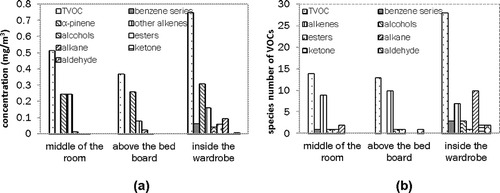
The sample inside the wardrobe contains much more alkanes, including decane, undecane, n-dodecane, and n-tridecane, and the concentration is also much higher than that of the room air. The other VOCs (including the benzene series, alcohols, esters ketones, and aldehydes) except the alkenes also showed a higher trend. In the sampling point in the middle of the room, concentrations of alkanes only accounted for 0.1% of the total concentration, while in the wardrobe the proportion reached 12.82%. This result shows that the wardrobe is the main source of alkanes and some other substances, because many adhesives, which can be considered the main source of alkanes, have been used inside the wardrobe. VOCs emitted by different adhesives mainly include alkanes such as n-decane, n-octane, n-nonane, n-undecane, C8–C11 branched alkanes, C8–C10 cyclohexanes, methylcyclohexane, dimethylcyclohexane, and trimethylcyclohexane (Girman et al., Citation1986; Browne, Citation1992).
Summary
In the newly built and furnished dormitory buildings, more than 500 kinds of VOCs were detected. The two VOC species with the highest detection rate are alkenes and alkanes; the other main substances include the benzene series, alcohols, esters, and ketones. Alpha-pinene is the VOC with the highest concentration in dormitories, and the average concentration is 0.785 mg/m3, which is much higher than for any other substances. The average total TVOC concentration is 2.436 mg/m3 in dormitories.
By analyzing the concentration and detection rate differences before and after installing furniture, the contribution of building materials and furniture materials to the total VOC concentration was quantified. Butyl ester 2-propenoic acid, hexamethylcyclotrisiloxane, propanoic acid 2-methyl-,3-hydroxy-2,4,4-trimethylpentyl ester, tetradecane, toluene, and pentadecane mainly come from the building materials. The α-pinene, n-butyl ether, β-pinene, cedrol, 3-carene, [3R-(3α,3aβ,7β,8aα)]-1H-3a,7-methanoazulene, and trimethyl-6-methylene- mainly come from the furniture; VOCs with both building material and furniture as sources include toluene, ethylbenzene, benzaldehyde, hexanal, and nonanal.
The pinewood bed boards are the main source of α- pinene in dormitories. The result shows that the contribution of bed boards to the α-pinene is 91.45%, and to TVOC is 91.77%. The wardrobes are the main source of some alkanes such as decane, undecane, n-dodecane, and n-tridecane.
About 1 year after furniture installation, most of substances have decayed more than 70%, including α-pinene, which is the main constituent of VOCs. However, the decay rate of benzene series is much lower.
Funding
This research was supported financially by a national key project of the Ministry of Science and Technology, China, on “Green Buildings and Building Industrialization” through grant 2016YFC0700500, and by the National Natural Science Foundation of China project 51278332 and the National Natural Science Foundation of China project 51678397 and 51308372.
Additional information
Funding
Notes on contributors
Jian Kang
Jian Kang is a graduate student at the Tianjin Key Laboratory of Indoor Air Environmental Quality Control, School of Environmental Science and Engineering, Tianjin University, Tianjin, People’s Republic of China.
Junjie Liu
Junjie Liu is a professor at the Tianjin Key Laboratory of Indoor Air Environmental Quality Control, School of Environmental Science and Engineering, Tianjin University, Tianjin, People’s Republic of China.
Jingjing Pei
Jingjing Pei is an associate professor at the Tianjin Key Laboratory of Indoor Air Environmental Quality Control, School of Environmental Science and Engineering, Tianjin University, Tianjin, People’s Republic of China.
References
- Bai, Z., Y. Dong, Z. Wang, and T. Zhu. 2005. Emission of ammonia from indoor concrete wall and assessment of human exposure. Environ. Int. 32(3):303–11. doi:10.1016/j.envint.2005.06.002
- Bari, M.A., W.B. Kindzierski, A.J. Wheeler, M.-E. Heroux, and L.A. Wallace. 2015. Source apportionment of indoor and outdoor volatile organic compounds at homes in Edmonton, Canada. Build Environ. 90:114–24.doi:10.1016/j.buildenv.2015.03.023
- Brown, S.K., M.R. Sim, M.J. Abramson, and C.N. Gray. 1994. Concentrations of volatile organic compounds in indoor air—A review. Indoor Air 4(2):123–34. doi:10.1111/ina.1994.4.issue-2
- Browne, G.J. 1992. Volatile organic emissions from carpet adhesives. Tucson, AZ: University of Arizona.
- Chan, S.C., S.C. Lee, W. Chan, K. Fai Ho, L. Tian, S.C. Lai, Y.S. Li, and Y. Huang. 2011. Characterisation of volatile organic compounds at hotels in southern China. Indoor Built Environ. 20(4):420–9.
- Choi, D.W., K.W. Moon, S.H. Byeon, I.E. Lee, D.G. Sul, and J.H. Lee. 2009. Indoor volatile organic compounds in atopy patients’ houses in South Korea. Indoor Built Environ. 31(7):279–84.
- Clobes, A.L., G.P. Ananth, A.L. Hood, J.A. Schroeder, and K.A. Lee. 1992. Human activities as sources of volatile organic compounds in residential environments. Ann. NY Acad. Sci. 641(4):79–86. doi:10.1111/nyas.1992.641.issue-1
- Du, Z.J., J.H. Mo, Y.P. Zhang, and Q.J. Xu. 2014. Benzene, toluene and xylenes in newly renovated homes and associated health risk in Guangzhou, China. Build Environ. 72:75–81. doi:10.1016/j.buildenv.2013.10.013
- Girman, J.R., A.T. Hodgson, and A.S. Newton. 1986. Emissions of volatile organic compounds from adhesives with indoor applications. Environ. Int. 12(1–4):317–21. doi:10.1016/0160-4120(86)90045-0
- Guo, H., N.H. Kwok, H.R. Cheng, S.C. Lee, W.T. Hung, and Y.S. Li. 2009. Formaldehyde and volatile organic compounds in Hong Kong homes: Concentrations and impact factors. Indoor Air 19(3):206–17. doi:10.1111/ina.2009.19.issue-3
- Gupta, K.C., A.G. Ulsamer, and P.W. Preuss. 1982. Formaldehyde in indoor air: Sources and toxicity. Environ. Int. 8(s1–6):349–58. doi:10.1016/0160-4120(82)90049-6
- Hollowell, C.D., and R.R. Miksch. 1982. Sources and concentrations of organic compounds in indoor environments. Bull. NY Acad. Med. 57(10):962–77.
- Jiang, C., S. Li, P. Zhang, and J. Wang. 2013. Pollution level and seasonal variations of carbonyl compounds, aromatic hydrocarbons and TVOC in a furniture mall in Beijing, China. Build Environ. 69(11):227–32. doi:10.1016/j.buildenv.2013.08.013
- Jones, A.P. 1999. Indoor air quality and health. Atmos. Environ. 33(28):4535–64. doi:10.1016/S1352-2310(99)00272-1
- Kim, Y.M., S. Harrad, and R.M. Harrison. 2001. Concentrations and sources of VOCs in urban domestic and public microenvironments. Environ. Sci. Technol., 35(6):997–1004. doi:10.1021/es000192y
- Lim, S, K. Lee, S. Seo, and S. Jang. 2011. Impact of regulation on indoor volatile organic compounds in new unoccupied apartment in Korea. Atmos. Environ. 45(11):1994–2000. doi:10.1016/j.atmosenv.2011.01.020
- Liu, Q.Y., Y.J. Liu, and M.G. Zhang. 2013. Personal exposure and source characteristics of carbonyl compounds and BTEXs within homes in Beijing, China. Build. Environ. 61(61):210–6. doi:10.1016/j.buildenv.2012.12.014
- Mishra, N., J. Bartsch, G.A. Ayoko, T. Salthammer, and L. Morawska. 2015. Volatile organic compounds: Characteristics, distribution and sources in urban schools. Atmos. Environ. 106:485–91. doi:10.1016/j.atmosenv.2014.10.052
- Rios, J.L.M., J.L. Boechat, M.C.K. Ramos, R.R. Luiz, F.R. de Aquino Neto, and J.R. Lapa e Silva. 2010. Asthma and rhinitis in office buildings workers and exposure to total volatile organic compounds (TVOC) and formaldehyde. J. Allergy Clin. Immunol. 125(2):AB210. doi:10.1016/j.jaci.2009.12.820
- Risholm-Sundman, M., M. Lundgren, E. Vestin, and P. Herder. 1998. Emissions of acetic acid and other volatile organic compounds from different species of solid wood. Holz als Roh- und Werkstoff 56(2):125–9. doi:10.1007/s001070050282
- Robinson, J., and W.C. Nelson. 1995. National human activity pattern survey data base. Research Triangle Park, NC: U.S. Protection Agency.
- Salonen, H.J., A.L. Pasanen, S.K. Lappalainen, H.M. Riuttala, T.M. Tuomi, and P.O. Pasanen. 2009. Airborne concentrations of volatile organic compounds, formaldehyde and ammonia in Finnish office buildings with suspected indoor air problems. J. Occup. Environ. Hyg. 6(3):200–9. doi:10.1080/15459620802707835
- Salthammer, T., S. Mentese, and R. Marutzky. 2010. Formaldehyde in the indoor environment. Chem. Rev. 110(4): 2536–72. doi:10.1021/cr800399g
- Sarigiannis, D.A., S.P. Karakitsios, A. Gotti, I.L. Liakos, and A. Katsoyiannis. 2011. Exposure to major volatile organic compounds and carbonyls in European indoor environments and associated health risk. Environ. Int. 37(4):743–65. doi:10.1016/j.envint.2011.01.005
- Schneider, P., I. Gebefugi, K. Richter, G. Wolke, J. Schnelle, and H.E. Wichmann. 2001. Indoor and outdoor BTX levels in German cities. Sci. Total Environ. 267(1–3):41–51. doi:10.1016/S0048-9697(00)00766-X
- Sollinger, S., K. Levsen, and G. Wünsch. 2015. Indoor pollution by organic emissions from textile floor coverings: Climate test chamber studies under static conditions. Atmos. Environ. 90(9):2369–78. doi:10.1016/1352-2310(94)90491-X
- Tang, X.J., Y. Bai, A. Duong, M.T. Smith, L.Y. Li, and L.P. Zhang. 2009. Formaldehyde in China: Production, consumption, exposure levels, and health effects. Environ. Int. 35(8):1210–24. doi:10.1016/j.envint.2009.06.002
- Tao, H., Y. Fan, X. Li, Z. Zhang, and W. Hou. 2015. Investigation of formaldehyde and TVOC in underground malls Xi’an, China: Concentrations, sources, and affecting factors. Build. Environ. 85:85–93. doi:10.1016/j.buildenv.2014.11.017
- Wallace, L. 1990. Exposures, risks, and sources associated with air toxics: Results from recent EPA studies of exposure to VOCs. EPA Report number 90-149.7. doi:10.1063/1.458450
- Wang, B., S.C. Lee, and K.F. Ho. 2007. Characteristics of carbonyls: concentrations and source strengths for indoor and outdoor residential microenvironments in China. Atmos. Environ. 41(13):2851–61. doi:10.1016/j.atmosenv.2006.11.039
- Wang, X., Y. Zhang, and J. Xiong. 2008. Correlation between the solid/air partition coefficient and liquid molar volume for VOCs in building materials. Atmos. Environ. 42(33):7768–74. doi:10.1016/j.atmosenv.2008.05.030
- Wolkoff, P. 1995. Volatile organic compounds—Sources, measurements, emissions, and the impact on indoor air quality. Indoor Air 5(5):5–73. doi:10.1111/(ISSN)1600-0668
- Yu, C., and D. Crumpt. 1998. A review of the emission of VOCs from polymeric materials used in buildings. Build. Environ. 33(6):357–74. doi:10.1016/S0360-1323(97)00055-3
- Zhao, Y., J. Shen, and X. Cui. 2015. Investigation of VOC released from three-layer parquet by using a new rapid detection method. Sci. Silv. Sin. 51(2):99–104.

